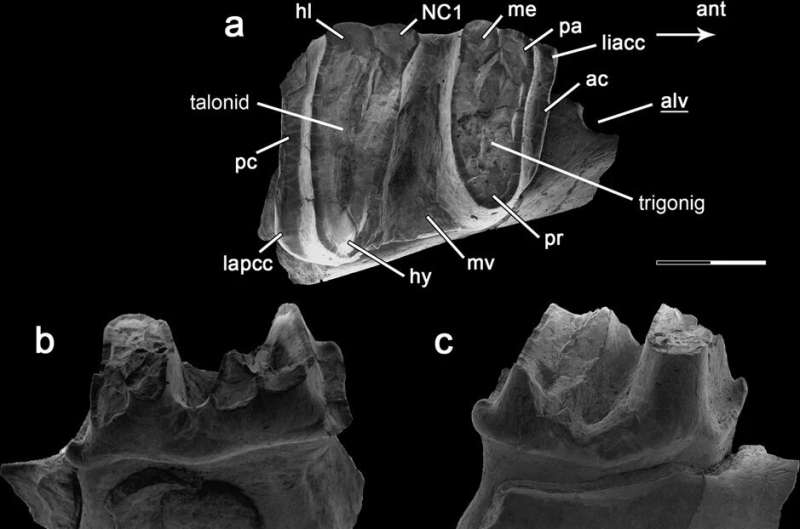February 28, 2023 report
This article has been reviewed according to Science X's editorial process and policies. Editors have highlighted the following attributes while ensuring the content's credibility:
fact-checked
peer-reviewed publication
trusted source
proofread
Oldest evidence of South American egg-laying mammals found in Patagonia

It was just a tooth and a fragment of jaw bone—discovered in an excavation layer of the Chorrillo Formation, a unique geological formation in Patagonia, Argentina. Field researchers found it amongst fossils of both terrestrial and aquatic mollusks, frogs, turtles, and snakes, as well as theropod and sauropod dinosaur fossils. Based on the sediment layer, the tooth dates from the Maastrichtian Stage, a timeframe at the end of the Late Cretaceous ranging from 72.1 million to 66 million years ago.
Surprisingly, the unusual morphology of the tooth clearly showed that it belongs to a member of the monotreme clade, the small group of egg-laying mammals that today includes the platypus and echidna. Further analysis found that the tooth is most similar to Australian platypuses older than 20 million years in the fossil record. Together, it shows a long history of conserved monotreme tooth morphology and an ancient connection between Australia and South America.
The research team from Argentina, Australia, and Japan have published their findings in a paper titled "First monotreme from the Late Cretaceous of South America" in Communications Biology.
This find isn't the first ancient platypus-like tooth found in Patagonia. Thirty years ago, paleo mammalogist Rosendo Pascual described a 62 million-year-old monotreme tooth, challenging what had been thought to be the clades exclusively Australasian existence. In honor of that discovery, the new find has been named Patagorhynchus pascuali. Patagorhynchus pascuali is older than the previous find.
How did it get there?
Most likely, it swam. Look at any map today, and you will see a lot of ocean between Australia and Argentina, many thousands of miles of deep water. But long ago, the lands were much closer. Even if Patagorhynchus pascuali only just arrived in Patagonia 70 million years ago it would have had an easy time making the trip.
Australia and Argentina were both much further south than they are today, connected to Antarctica or only separated by small islands and channels. The circumpolar environment would have been warmer than it is today, supporting a more vibrant animal and plant life. If the tooth does belong to a creature that closely resembles a modern-day platypus, a good river and lake swimmer like that would have no problem traversing coastal waters or short stretches that once separated South America from Australia.
It may be interesting to note that a different clade of mammal, marsupials, often regarded as a quintessentially Australian animal, didn't originate there. The Australian marsupials of today originated in South America and likely took a similar path (in reverse) as the Patagonian platypus over 50 million years ago.
More about monotremes
Monotremes are a group of mammals that lay eggs instead of giving birth to live young. They have other special features, such as a cloaca—a single opening for excretion and reproduction—a trait they have in common with all amphibians, reptiles, and birds. While the rest of us mammals stopped laying eggs over 160 million years ago, monotremes stuck with it.
More information: Nicolás R. Chimento et al, First monotreme from the Late Cretaceous of South America, Communications Biology (2023). DOI: 10.1038/s42003-023-04498-7
Journal information: Communications Biology
© 2023 Science X Network





















